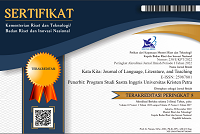Perceived Meaning on McDonalds’ Happy Meal® Promotional Videos by Blue and White Collar Workers in Surabaya
DOI:
https://doi.org/10.9744/katakita.6.2.224-229Abstract
This study observes the perceived meanings of McDonalds’ Happy Meal®promotional videos produced by two different social classes of workers, which are White and Blue Collar workers as respondents. After finding out what the perceived meanings are from the respondents, writer proceeds on to the analyzing process in order to find out the differences between White and Blue Collar respondents’ perceived meanings. The study uses descriptive qualitative approach to explain the meaning of qualitative material in a more systematic way. The writer concludes that white collar respondents tend to prioritize pride, prestige and esteem. Meanwhile, blue collar respondents tend to prioritize their primary needs and responsibilities before spending on secondary needs.
References
Adi, Tri Nugroho. (2013, July 7). Fiske: Audience Power. Retrieved November 29, 2017 Retrieved from: https://sinaukomunikasi.wordpress.com/2013/07/01/fiske-audience-power/
Ary, Donald., Jacobs, C. L., & Sorensen. C. (2010). Introduction to Research in Education. Wadsworth: Cengage Learning.
Bina Nusantara University. (n.d.). Teori Semiotika. Retrieved from: http://library.binus.ac.id/eColls/eThesisdoc/Bab2/2013-2-00577-JP%20Bab2001.pdf
Chandler, Daniel. (2007). Semiotics the Basics. Routledge 2 Park Square, Milton Park, Abingdon, Oxon OX14 4RN.
Creswell, John. W. (2003). Research design: qualitative, quantitative, and mixed methods approaches 2nd ed. Thousand Oaks, California: Sage Publication, Inc.
Deloxier, Wayne. M. (1976). The marketing communications process. United States of America: MCGraw-Hill, Inc..
Drewniany, L. Bonnie., & Jewler, Jerome. A. (2005). Creative Strategy in Advertising. Belmont, CA: Wadsworth/Thomson Learning.
Georgetown University. (2006, February 7). The Theory of Signs and the Role of the Reader. Retrieved from: http://faculty.georgetown.edu/irvinem/theory/Eco-TheoryofSigns-BMMLA-1981.pdf
Investopedia. (2017). Blue Collar. Retrieved from: http://www.investopedia.com/terms/b/bluecollar.asp
Lane, Ronald.W., & Russell, Thomas.J. (2001) Advertising a Framework.. Upper Saddle River, NJ: Prentice-Hall, Inc.
Leo, Melita. (2016). A Semiotic Analysis on the Perceived Meanings of Coca Cola “Anthem” Video Commercial. Previous thesis of English Literature Petra Christian University.
McDonaldsID (2017, April 4th). Happy Meal® Smurf The Lost Village. Retrieved August 18th, 2017 Retrieved from: https://www.youtube.com/watch?v=FdHO3d7nGDo
McDonaldsID (2017, August 7th). Happy Meal® Emoji. Retrieved August 18th, 2017 Retrieved from: https://www.youtube.com/watch?v=WjZJUc0Hfys
McDonaldsID (2017, February 13th). Happy Meal® Lego Batman. Retrieved August 18th, 2017 Retrieved from: https://www.youtube.com/watch?v=AdH6Di1XS3c
McDonaldsID (2017, July 10th). Happy Meal® Despicable Me 3. Retrieved August 18th, 2017 Retrieved from: https://www.youtube.com/watch?v=5DK6upH3E6Q
McDonaldsID (2017, May 2nd). Happy Meal® Super Mario. Retrieved August 18th, 2017 Retrieved from: https://www.youtube.com/watch?v=CiIcl5HGYj4
McDonaldsID. (2017) Retrieved from: https://www.youtube.com/user/McDonaldsID
Melnick, Meredith. (2011, November 7). Fast Food’s Biggest Customers: Not the poor but the middle class. Retrieved November 29, 2017 Retrieved from: http://healthland.time.com/2011/11/07/fast-foods-biggest-customers-not-the-poor-but-the-middle-class/
Olson, C.Jerry., & Peter, Paul.J. (1990). Consumer behavior and marketing strategy. RICHARD D. IRWIN, INC., United States of America.
Richard, J., Platt, J., and Weber, H. (1985). Longman dictionary of applied linguistics. England: Longman Group.
Rifai, Bachtirar. (2010). A SEMIOTIC ANALYSIS ON COCA-COLA’S COMMERCIAL ADVERTISEMENTS. Retrieved from: http://repository.uinjkt.ac.id/dspace/bitstream/123456789/836/1/94818-BAHTIAR%20RIFA%27I-FAH.pdf
Schlosser, E. (2002). Fast Food Nation. London, England: Penguin Group
University of California Los Angeles. (n.d.). semiotics. Retrieved from http://classes.design.ucla.edu/Fall07/154A/resources/alt_semiotics.pdf
Downloads
Issue
Section
License
Authors who publish with this journal agree to the following terms:- Authors retain copyright and grant the journal right of first publication with the work simultaneously licensed under a Creative Commons Attribution License that allows others to share the work with an acknowledgement of the work's authorship and initial publication in this journal.
- Authors are able to enter into separate, additional contractual arrangements for the non-exclusive distribution of the journal's published version of the work (e.g., post it to an institutional repository or publish it in a book), with an acknowledgement of its initial publication in this journal.
- Authors are permitted and encouraged to post their work online (e.g., in institutional repositories or on their website) prior to and during the submission process, as it can lead to productive exchanges, as well as earlier and greater citation of published work (See The Effect of Open Access).














